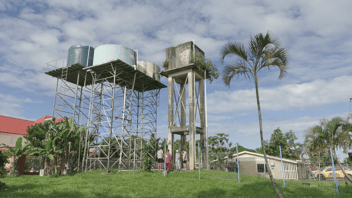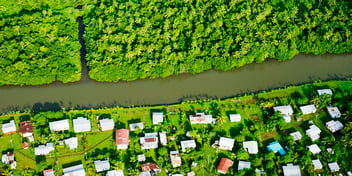Rough seas ahead: Climate change in the South Pacific
Climate refugees, disappearing islands and plans to relocate entire nations – these are some of the more headline-grabbing impacts of climate change in the South Pacific.
What we don’t always hear about is the chronic symptoms already being felt in the region.
But Managing Director of Samoa Water Authority (SWA), Seugamaalii Jammie Saena, can share a long list.
“Sea level rise, saltwater intrusion, increasing evaporation rates and changing rainfall patterns have affected the water cycle and, potentially, the availability of water for human use,” she said.
“For the South Pacific, where a majority of the population resides on vulnerable, low-lying islands with flood-prone catchments and drought-prone atolls, climate change has undoubtedly become a household name in the most recent years.”
Water and sanitation in the region
Water, sanitation and climate change are inextricably linked, Saena stressed.
“Increased extreme flooding can result in loss of water sources – the same from reduced rainfall and over-abstraction,” she said.
“Slow on-set rise of sea level in the future could easily affect the supply and quality of ground borehole water when faced with over-abstraction.”
And without clean water, Saena warned that diseases such as diarrhoeal disease placed small and vulnerable island populations at high risk.
“Declining water availability and increased flooding will pose major threats to sewerage and septic systems heavily reliant on water,” she said.
Mediating the effects
Many Pacific Island countries have set up dedicated government bodies to guide climate change adaptation, said Dr Jeremy Kohlitz, senior research consultant with the University of Technology Sydney’s Institute for Sustainable Futures.
“A lot are focused on the disaster aspects of climate change – early monitoring systems to alert people when a cyclone is coming and strategies to expedite recovery,” he said.
“In rural communities there’s a lot of focus on connecting good communication with disaster response authorities and a strong focus on technological solutions to make water and sanitation more robust.”
Saena added that other major efforts included plant restoration in water catchment areas, increased surveillance of water quality and supply during extreme weather events, sustainable development initiatives using renewable energy, and greenhouse gas reduction mechanisms.
 King Tides flooding on the island of Kiribati in the Pacific Ocean.
King Tides flooding on the island of Kiribati in the Pacific Ocean.
Working together
Acknowledging that climate change is indeed a shared problem, many international partners have stepped in to help.
As Griffith University senior lecturer in Environmental Health, Dr Cara Beal, said: “The good news is that there is some great collaborative, applied research being done”.
“Using local knowledge and building up local skills and capacity can strengthen the resilience of rural villages to disruptions to water and sanitation systems,” said Beal, a senior research fellow at Griffith’s Cities Research Institute.
In Samoa, Young Water Professional (YWP) Christina Mualia is involved in local projects as part of the 28-nation, $1.2 billion Climate Investment Funds Pilot Program for Climate Resilience (PPCR).
“Projects include extending the coverage of SWA’s network to include communities in further away areas and enhance their resilience,” said Mualia, a Technician Officer with the Wastewater Division of SWA.
“[Projects also include] ensuring access to consistent treated water supply, and relocating pipelines inland to provide for populations that have relocated away from vulnerable coastal areas to escape sea level rise, storm surges and flooding.”
Meanwhile, for engineering and management consultancy Beca, the focus has been on not only helping to design water and wastewater solutions, but also strategic planning.
“We’re doing a lot of port, wharf and coastal protection work in the Solomon Islands, Cook Islands, Vanuatu and Fiji,” said Kristina Hermens, Beca Business Director – Three Waters.
“In the Marshall Islands we’ve recently completed a 20-year strategic and development plan for the capital, Majuro.”
More work needed
While there are countless examples of work underway, plenty more could be done.
Saena’s wish list included improved infrastructures and building standards for water supplies, flood proof bridges and river walls, current barriers and early warning systems coverage.
From a research perspective, Beal suggested further work was needed, “especially in monitoring and evaluating research outcomes and existing water and sanitation management frameworks".
“A better understanding of local cultural, social and governance mechanisms that drive community-based management of water and sanitation systems will help to identify barriers to future-proofing safe, accessible and acceptable water, and sanitation for both rural and urban populations.”
And this is perhaps the crux of the issue – ensuring that climate change adaptation efforts are both appropriate and sustainable within their unique setting.
As ISF’s Kohlitz stressed: “It’s not just a matter of Australian organisations going out and saying ‘do it this way, do it that way’. It’s about working with the communities to co-produce solutions."
 River flooding a road at Nausori Highland, Navala, Viti Levu, Fiji.
River flooding a road at Nausori Highland, Navala, Viti Levu, Fiji.
Sustainable action
For Kohlitz, appropriate and sustainable collaboration means merging top-down and bottom-up approaches.
“So taking the scientific knowledge that water organisations in Australia have and then communicating that at a community level where people might not have a strong understanding of what climate change is,” he said.
“The bottom-up approach is where communities are able to communicate their own contextual, local or traditional knowledge to water organisations so that we can come up with solutions that are both scientifically sound, but also appropriate for these local areas.”
Beal was keen to make the distinction that collaboration did not mean consultation.
“Collaboration takes longer and is more frustrating and complex than consultation,” she said.
“But it is much more likely to result in positive and practical outcomes and benefits for community.”
Samoan YWP Mualia also pointed out that those wishing to engage needed to respect local professionals.
“While developing countries like those in the Pacific remain grateful to donor countries ... there are gaps that need to be addressed,” she said.
“Donors are asked to tailor their assistance to align with a working environment that differs from their
own both in terms of resources and processes.”
Director of Science and Systems at Climate Risk Karl Mallon has been exploring adaptive asset management in the region and said that collaborative efforts could make a real difference.
“In some ways it’s easier to get things done in these countries because access to decision makers and political leaders is easier,” he said.
“And because their assets have been built much more recently, things like their GIS systems are not just good, they’re also relatively complete.”
What lies ahead
While the headlines might tell a story of disappearing islands, climate refugees and entire countries relocating, that’s not necessarily the way of the future, said ISF’s Kohlitz.
“There is significant uncertainty associated with the geomorphology of the islands – they may just change shape or even grow because of how ocean currents change and sediments are deposited,”
he said.
“It’s worth mentioning because a lot of people say ‘well why put money into Kiribati or other low-lying atolls if they’re just going to be gone in a few decades?”
And if we’re not prepared to help climate change adaptation efforts in the South Pacific, then what does the future hold for us?
“This issue impacts everyone,” reminded Saena.
“The future should look like everyone is aware of the seriousness and enormity of the challenges we face – they should work and live as if the last drop of water is the next one they drink."
First published in Current magazine October 2018.


